CLL (Coimbra, Portugal)
Research highlights
CLL
Chemistry Department, University of Coimbra
3000-535 Coimbra, Portugal
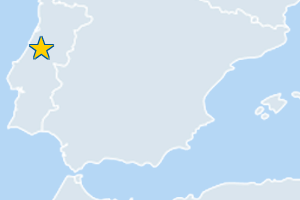
http://www.uc.pt/en/uid/laserlab
Contact:
Luís Arnaut
CLL focuses on areas such as photodynamic therapy, organic polymeric and inorganic photovoltaics, optical sensors, light-emitting devices, matrix isolation spectroscopy and photochemistry, conformation dependent reactivity, hot vibrational chemistry, properties of transient species, photocatalysis, DNA delivery and skin permeation, and photochemistry to art conservation.
Industrial Collaboration
Ongoing project with LaserLeap Tech, SA , "FOTOVID Viral photo-inactivation in the control of the COVID-19 pandemic”, (Sep 2020 – Jun 2021).
Amyloid aggregation
Using amyloid intrinsic fluorescence, spinning-disk confocal microscopy and scattering experiments the aggregation pattern of Aβ42 in presence of a novel class of potential multitarget anti-Alzheimeŕs drugs was screened. Together with in vitro and in vivo results towards cholinergic deficiency and mitochondrial systems, a lead structure was clearly identified, validating the multiple disease-relevant targets strategy used. [Bioorg. Chem. 107, 104596 (2021)]
Cyclometalated Pt(II) Complexes
The photophysical characterization of five novel cyclometalated platinum(II) compounds containing five different alkynyl-chromophores was achieved. It was observed that the spectral and photophysical characteristics of the cyclometalated platinum(II) complexes (Pt–Ar) are essentially associated with the platinum-cyclometalated unit. Room-temperature emission of the Pt–Ar complexes was attributed to phosphorescence in agreement with DFT calculations.
[Inorg. Chem. 59, 8220–8230 (2020)]
N,N′-disubstituted indigo derivatives
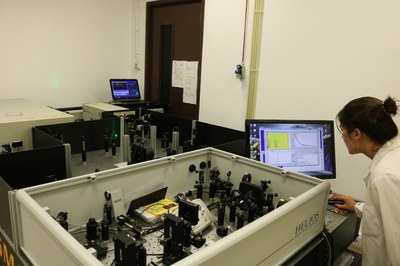 A comprehensive characterization of the excited state properties of five N,N′-substituted indigo (Ind) derivatives (acetyl-, benzoyl-, methoxybenzoyl-, nitrobenzoyl- and chlorobenzoyl-) was undertaken in various solvents and temperatures. In the excited state, rotation around the central double bond was found with N,N′-diacetylindigo (DAI) and N,N′-dibenzoilindigo (DBI) derivatives. [Dyes and Pigments 176, 108197 (2020)]
A comprehensive characterization of the excited state properties of five N,N′-substituted indigo (Ind) derivatives (acetyl-, benzoyl-, methoxybenzoyl-, nitrobenzoyl- and chlorobenzoyl-) was undertaken in various solvents and temperatures. In the excited state, rotation around the central double bond was found with N,N′-diacetylindigo (DAI) and N,N′-dibenzoilindigo (DBI) derivatives. [Dyes and Pigments 176, 108197 (2020)]
Conformational switching
The molecule 4-amino-2,6-dimethoxypryimidine was subjected to conformer switching studies. Consistent with theory, two conformers were observed after deposition of the molecule onto the cold matrix window. Subsequent UV irradiation of the matrix caused the formation of a third and new rotamer. The results from the project have been included in an MSc thesis. The project also served as training and exchange of knowledge in matrix-isolation spectroscopy and inspiration for the renovation of the laboratory in Copenhagen to allow for laser irradiation and recording of both infrared and UV-VIS signatures. [Crystals 13 (2023) 1130; J. Am. Chem. Soc., 144 (2022) 20866; Chem. Eur. J., 28 (2022) e202202306; J. Raman Spectrosc., 53 (2022) 1904; Chem. Soc. Rev., 51 (2022) 2853; Chem. Soc., 143 (2021) 8266; J. Phys. Chem. A, 125 (2021) 6394]
Photochemical and Photophysical Characterization
Photochemical and Photophysical Characterization includes the determination of all the relevant quantum yields, lifetimes and rate constants associated to the deactivation of the excited states and associated imaging techniques. Examples of available techniques in the CLL are: broadband pump-probe femtosecond transient absorption, femtosecond fluorescence upconversion and high-resolution Raman mapping/imaging system. [J. Am. Chem. Soc., 144 (2022) 15252; Chem. Sci. 12, (2021) 303; Journal of Energy Storage 57, (2023) 106201; Communications Chemistry 4, (2021) 89]
Projects performed by external users >>
Further application highlights
Lasers and Cancer Lasers and Water Lasers for Cultural Heritage
Expertise
CLL is: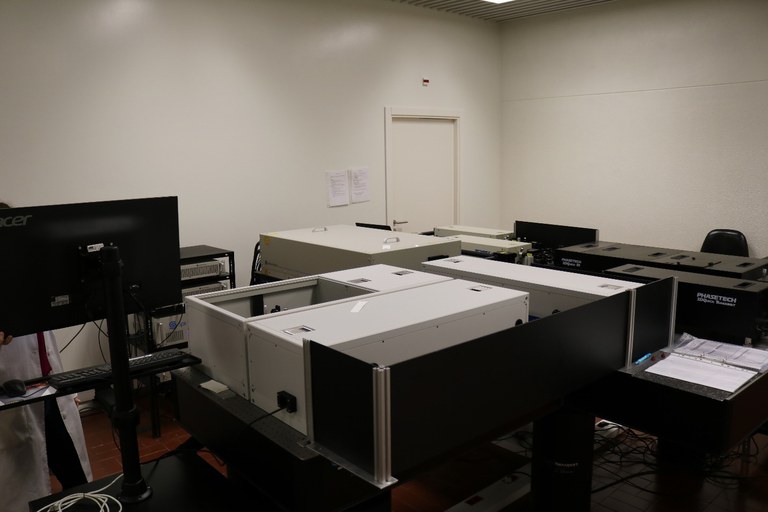
- a leader in time-resolved photoacoustics
- a leader in matrix isolation spectroscopy, photochemistry and solid-state hot vibrational chemistry
- a reference laboratory for time-resolved single photon counting
- equipped for state-of-the-art femtosecond transient absorption measurements with NIR/VIS/NIR detection
- a unique facility integrating fs/ps/ns measurements of transients in solutions, films, supercritical fluids, cultured cells flow cytometry, and low temperature matrices. CLL recently installed photoacoustic tomography in an associated animal facility, a Two-Dimensional Infrared spectrometer (2D-IR) and a broadband fluorescence upconversion spectrometer.
Expertise in recyclable materials
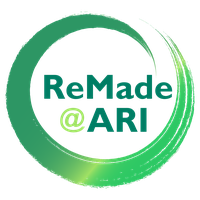 CLL, through the Laboratory of Molecular Cryospectroscopy and Biospectry (LMCB) is a member of the consortium ForestWise, and participates in the projects RESFINAS and ResetFinas, which focus on the development of recyclable materials for application in the resins-bases industries, aiming to replace fossil-based raw materials by green raw materials for the production of varnishes, paints and glues and, among other materials. CLL is also involved in various research international collaborative projects which address the development of green-chemistry, recyclable sensors and catalysts.
CLL, through the Laboratory of Molecular Cryospectroscopy and Biospectry (LMCB) is a member of the consortium ForestWise, and participates in the projects RESFINAS and ResetFinas, which focus on the development of recyclable materials for application in the resins-bases industries, aiming to replace fossil-based raw materials by green raw materials for the production of varnishes, paints and glues and, among other materials. CLL is also involved in various research international collaborative projects which address the development of green-chemistry, recyclable sensors and catalysts.
- since 2022: RESFINAS - Modification of Colophony Resins to Promote Compatibility of Their Derivatives with Polyolefins Produced by Metallocene Catalysis. Area II.M2.C PRR (€393,974.68 EUR). Participant institutions: Forestwire Consortia (40 Portuguese Institutions from the domain of the resins – Industrial companies, R&D institutions, private institutions, municipalities, etc…)
- since 2022: ResetFinas – Set Up for Modification of Colophony Resins to Promote Compatibility of Its Derivatives with Polyolefins Produced by Catalysis with Metallocenes. Area II.M2.F-PRR (€85,108.13 EUR). Participant institutions: Forestwire Consortia (40 Portuguese Institutions form the domain of the resins – Industrial companies, R&D institutions, private institutions, municipalities, etc…)
Circular economy of new production methods for the generation of high purity silicon and silicon added value compounds.
It is intended to obtain silicon oxide (and silicon) and silicon carbide, with a high degree of purity (greater than 99.8%) from rice husk. It is intended to develop new processes and methods, minimizing the energy cost. The work starts from a laboratory scale in which it is intended to determine the influence of several variables on which the processes depend (such as composition, temperature, stoichiometry), on the efficiency of the new proposed processes. It is intended to investigate the reaction mechanisms associated with the processes. The first objective will be to use more efficient pre-treatment processes, using physical and chemical methods that allow achieving high purity and morphological control. The second objective involves the use of thermal processes with magnesium in order to reduce the pyrolysis temperature from 1400-1800 °C to 500-900 °C, lowering the footprint and energy bill. Also, new laser-based processes will be developed. Bio silica added value composite compounds will be synthesized.
- since 2023: Green Innovation for Automotive Industry: New method for high purity silicon generation.
Services for industry
Chemical
Characterisation - Studies of steady-state and time-resolved fluorescence, transition absorption, photoacoustics and Infrared and Raman spectroscopies.
Materials
Characterisation - Chemical characterization of solid materials through the techniques of Raman and IR associated with imaging and microscopy.
Medical Technologies
Consultation - Expertise in the domains of Photodynamic Therapy and Photoacoustic Imaging for diagnosis.
Microscopy - Microscope capable of acquiring steady state and time-resolved fluorescence, giving a microcopic image based on the fluorescence lifetime of contrast agents.
For more information, contact the Laserlab Office.
Search for other industry services>>
Equipment offered to external users
- Photoacoustics
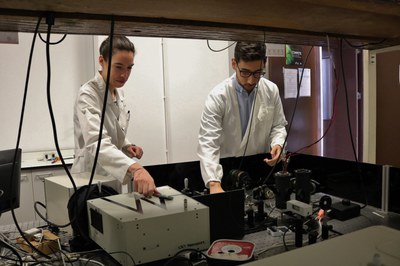
- Calorimetry flow cells
- Transducers and hydrophone for photoacoustic detection.
- Pulsed excitation sources
- Lasers
- CO2 LASER (Synrad Firestar TI80): CW laser for promoting reactivity and for material processing.
- NdYAG laser coupled with galvo head (Barch MOPA color 30W): Material processing (engraving) and nanoparticle production.
- Nitrogen laser
- Dye laser
- Diode lasers at 633 nm, 649 nm, 748 nm (10-40 mW), 748 nm (100 mW).
- Ar+continuous Laser
- Two fs-laser amplifiers with broadband optical parametric amplifiers (OPA)
- Spectrometers
- Broadband pump-probe femtosecond transient absorption spectrometer
- Femtosecond fluorescence upconversion spectrometer
- Two-Dimensional Infrared, 2D-IR, spectrometer
- Raman spectrometer (Nicolet DXR SmartRaman), with commutable excitation lasers in the visible and IR range.
- High-resolution Raman mapping/imaging system, covering all spectral range from near-IR to UV, and with submicron spatial resolution.
- UV/visible spectrometer (ScanSci) interfaced with the cryostats.
- Raman mapping: confocal microspectrometer
- Fluorescence spectrophotometers and fluorimeters, phosphorimeters etc.
- UV-VIS-NIR absorption spectrophotometers
- Nanosecond and picosecond time correlated single-photon counting systems
- Cryostats capable of providing temperatures down to 4 K.
- Oven for higher-temperature work
- Infrared mapping/imaging Nicolet system
- Monochromator for irradiation experiments at low temperature and different broadband sources (Xe/(Hg), Xe, D).
- Supercritical fluid spectroscopy
- Fluorescence microscope for cell culture
- Fluorescence Lifetime Imaging Microscopy (FLIM):FLIM is a molecular fluorescence lifetime-based microscopy technique used to map the spatial distribution of cells and materials. Fluorescence is sensitive to the environment, which provides the advantages of the FLIM technique together with molecular contrast given by the endogenous/exogenous fluorophores.
- Led illuminator (LuzChem LEDi-KIT3): Variable intensity, space and time stable led station with various wavelengths available.
- Molecular Rotational Resonance (MRR): A broadband molecular rotational resonance (MRR) spectrometer (2-8 GHz) is available. This instrument can perform chirped-pulse Fourier transform microwave (CP-FTMW) spectroscopy in samples prepared via supersonic jet expansions. This high-resolution technique is designed to survey complex mixtures, aiding in structural elucidation studies. Multi-component analysis is possible, including conformers, enantiomers, and isotopically enriched species. The MRR instrument available is a BrightSpec 2-8 GHz spectrometer using a direct-circuit scheme with three pulsed nozzles running simultaneously.

